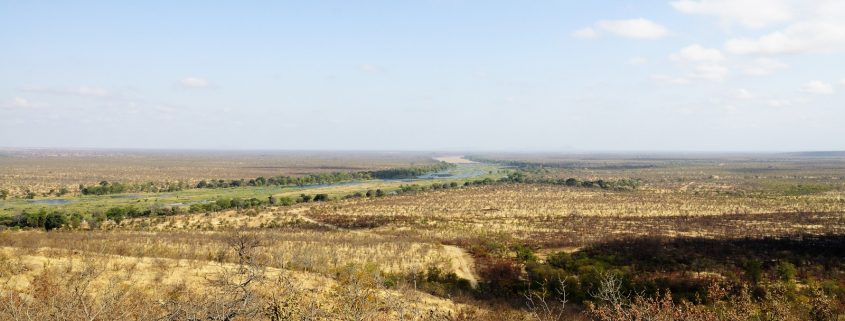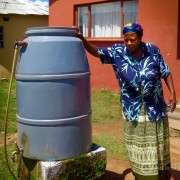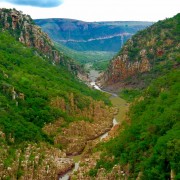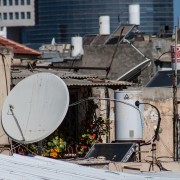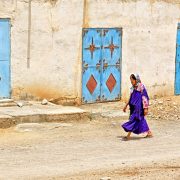Drought-Hit Zimbabwe Unravels Amid Humanitarian, Economic, and Political Crises
Protests threaten to unseat Mugabe government, while four million people face hunger.
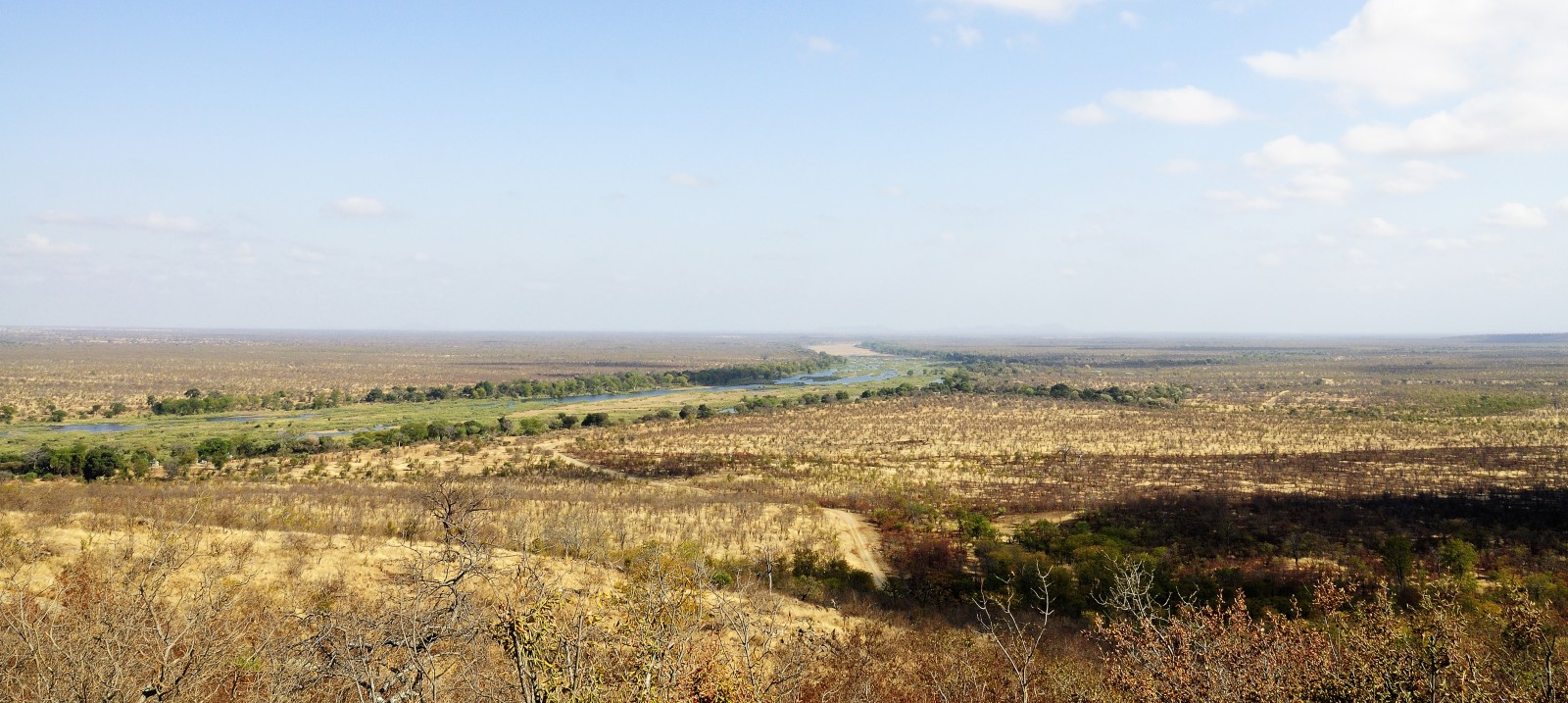
The Runde River flows through southeastern Zimbabwe, where rainfall between October 2015 and February 2016 was less than 65 percent of the long-term average. Photo courtesy Andrew Ashton via Flickr Creative Commons.
By Codi Kozacek
Circle of Blue
As citizens continue to gather in mass demonstrations in the streets of Harare and other cities across Zimbabwe, observers in the country speculate the nearly three-decade rule of strongman President Robert Mugabe may finally be nearing its end. The protests, which some have likened to the Arab Spring uprisings in northern Africa, have gained steam since a July strike that shut down the capital city. They have been met with increasingly violent crackdowns by security forces, but demonstrators continue to call for the resignation of the 92-year-old Mugabe.
Drought has come more like a curse in that it is adding to the misery that is already unfolding.” –Farai Maguwu, Executive Director, Centre for Natural Resource Governance
By this measure alone, Zimbabwe is a nation in turmoil. But it is just one of many long-simmering challenges now erupting across the country. Closely intertwined with the protests is an increasingly severe cash shortage that has delayed payments to teachers, the military, and other government workers. Government plans to introduce bond notes garnered especially strong opposition in August. Meanwhile, with attention riveted on the unrest in Zimbabwe’s cities, a slow-motion catastrophe is unfolding in its countryside. There, an estimated four million people face hunger in the wake of southern Africa’s worst drought in more than three decades. If the situation is not urgently addressed, aid groups warn that rural communities could lose years of hard-won development gains.
None of these things — droughts, economic emergencies, political unrest — are new to Zimbabwe. A strong drought in 1992 killed more than a million cattle and forced Zimbabwe, then a net food exporter, to import grain, and chronic hunger and poverty continue to afflict rural communities. In 2007, a hyperinflation crisis forced the government to abandon the local currency in favor of the U.S. dollar and South African rand. The episode channeled discontent with Mugabe through opposition parties such as the Movement for Democratic Change, and citizens mobilized in large protests.
The difference this time is the severity and scale at which all three are occurring simultaneously. Coupled with political infighting and Zimbabwe’s strained relationships with foreign partners, it has escalated the crisis to a boiling point.
On a global scale, Zimbabwe’s emergency offers another case study in the importance of good governance and economic policy to reduce the risks from climate change. Over the past decade, international security institutions have hypothesized that extreme droughts and floods wrought by climate change will act as a “threat multiplier” that can destabilize countries. In Zimbabwe it is clear that reality is much more nuanced. Drought did not cause the unrest. Rather, it has unmasked existing weaknesses in the government’s ability to build a strong economy that can withstand shocks like droughts, and to help those in need when such shocks occur. Experts drew similar conclusions from the Arab Spring uprisings and the civil war in Syria, emphasizing that drought does not act on its own, and that economic plight and political repression drive public discontent much more so than extreme weather events.
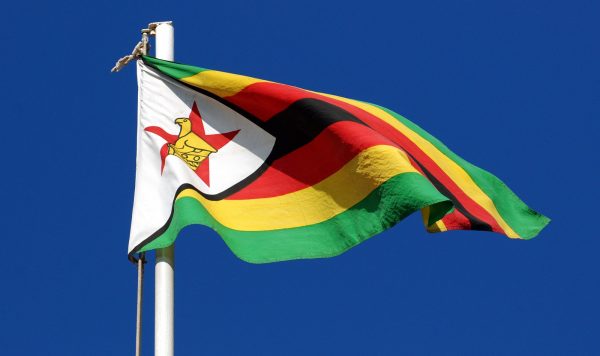
Zimbabwe’s flag became the symbol of an online protest movement called #ThisFlag, which began in May when a pastor in Harare posted a video of himself with the flag describing the injustices in his country. Photo courtesy Harvey Barrison via Flickr Creative Commons.
“Drought has come more like a curse in that it is adding to the misery that is already unfolding. Without the drought, Zimbabwe was in a very bad shape already, but the drought has further exposed this government,” Farai Maguwu, executive director of the Centre for Natural Resource Governance in Harare, told Circle of Blue. “They could not get a quality crop this year because of the drought, so that makes people depend on assistance from the state, and the state does not have the capacity to mitigate the effect of the drought.”
“There is a growing consensus in the business community, in the farming community, across the political divides that the government has failed to address the economic crisis,” Maguwu said. “So everyone, even within the government itself, is looking beyond the current government, thinking that it is not the best captain to steer our ship out of this predicament. It is encouraging people to fight, to come up in the streets. Something we have not seen for many years is beginning to happen. Everyone is emboldened. People are hopeful that this is the right time to rise up and push for a new government.”
Droughts Destroy Harvests, Trigger Food Crisis
The depth of Zimbabwe’s food emergency is hard to understate. Estimates indicate that as many as 4 million people will need food assistance over the next six months. That figure represents nearly half of Zimbabwe’s rural population, and is more than six times the levels seen over the past four years.
The most immediate reason so many people face hunger is a severe drought linked to the worst El Nino to hit southern Africa in more than three decades. The weather phenomenon, also one of the strongest ever recorded globally, wilted harvests and dried wells throughout the region over the past year. Overall, more than 40 million people across southern Africa are in need of humanitarian aid, according to a $US 2.4 billion appeal launched by the Southern African Development Community in June. The effects of El Nino, however, have not been distributed equally. In relatively strong states like South Africa, the drought delivered a major economic blow to farmers. In more vulnerable countries, like Zimbabwe, the consequences are life threatening.
During the November to March growing season last year, extremely dry weather triggered by El Nino cut Zimbabwe’s cereal production to half the five-year average and killed more than 23,000 cattle. In addition, so many cattle were starving and losing weight that many households had to sell their herds at giveaway prices. The losses were felt even more acutely because it was Zimbabwe’s second consecutive year of drought. Recognizing the severity of the situation, the federal government in February appealed for $US 1.5 billion in international assistance to help it respond.
Conditions continued to deteriorate over the spring and summer, and are expected to worsen throughout the next six months.
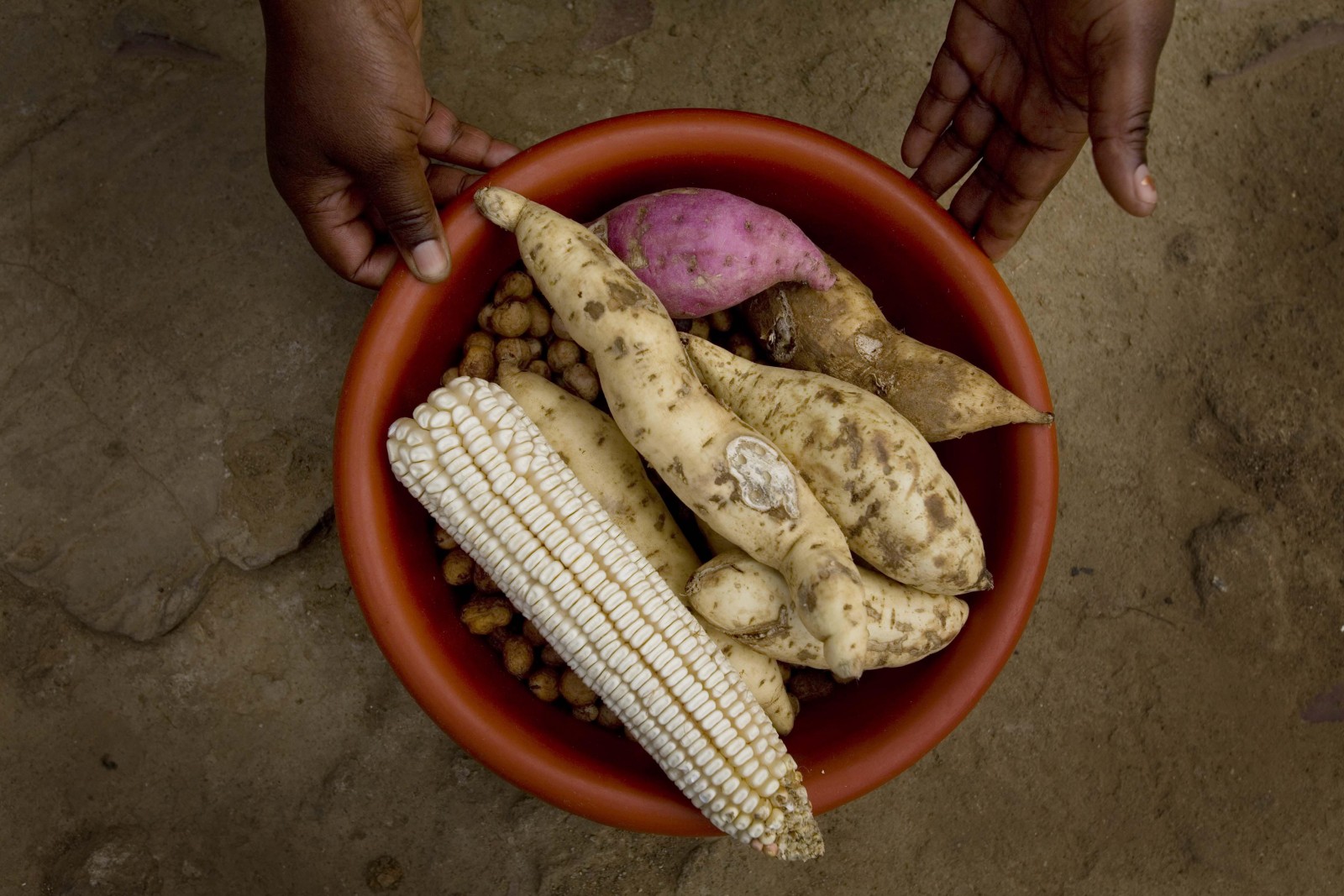
Baskets of food, like this one distributed to internally displaced communities in Zimbabwe in 2009, are just one form of assistance aid agencies provide. Many instead prefer to give cash transfers, but Zimbabwe’s cash shortage could hinder such programs over the next six months. Photo courtesy Kate Holt / IRIN via Flickr Creative Commons.
“At this time of year, most households should have cultivated and harvested stocks that would take them through the next harvest. Unfortunately, most of these households were unable to harvest anything, so they depend on some form of assistance,” said Eddie Rowe, Zimbabwe country director for the World Food Programme in Harare.
Typically the WFP runs a lean season assistance program between October and March to help farmers secure food between harvests. This year, the agency extended the 2016 program through April, and started providing 2017 assistance four months early, in May. Still, child malnutrition rates in the country are alarming, Rowe told Circle of Blue, with global acute malnutrition — an international benchmark — climbing above 10 percent in some districts.
“We have never recorded over the last 10 years such alarming GAM rates,” Rowe said. “A major issue we are worried about is the worsening situation on the nutritional status, and if La Nina materializes that would be a key area that we would have to focus on.”
A La Nina weather pattern, the opposite of El Nino, is concerning because it could bring devastating floods to southern Africa and would be the third major shock to Zimbabwe farmers in as many years. The latest forecasts released this month by the National Oceanic and Atmospheric Administration found a 40 percent chance that a La Nina will develop by the end of the year.
A ‘Deadly Cocktail’ Threatens Response
The outlook for Zimbabwe is especially ominous given the country’s economic and political plight, the regional nature of the drought in southern Africa, and the strained budgets of aid operations worldwide. Combined, these dynamics have not only eroded citizens’ ability to feed themselves, but also their ability to seek other means of employment and income. They have hobbled the government’s ability to help those in need. And they present a significant challenge to providing adequate international humanitarian assistance.
“You have a situation where there is a deadly cocktail of negative factors which directly have impacts on the basic livelihoods of millions of Zimbabweans,” said Rowe. “That’s the scenario in which we are operating.”
First is the disappearance of traditional coping mechanisms rural communities would normally use in the event of a severe drought and food shortage. In the past, farmers could earn extra money by taking on jobs in construction or other day labor. Amid Zimbabwe’s sharp economic downturn, those opportunities have disappeared, according to Alice Thomas, the climate displacement program manager for humanitarian organization Refugees International. Thomas and her team traveled to Zimbabwe in June and spoke with families in the hard-hit provinces of Matabeleland North and Masvingo. Farmers there reported that they could not find jobs even in the cities, where businesses had closed. Others said family members had migrated to South Africa in search of work, but they eventually returned due to a lack of jobs and tensions between foreign laborers and South Africans.
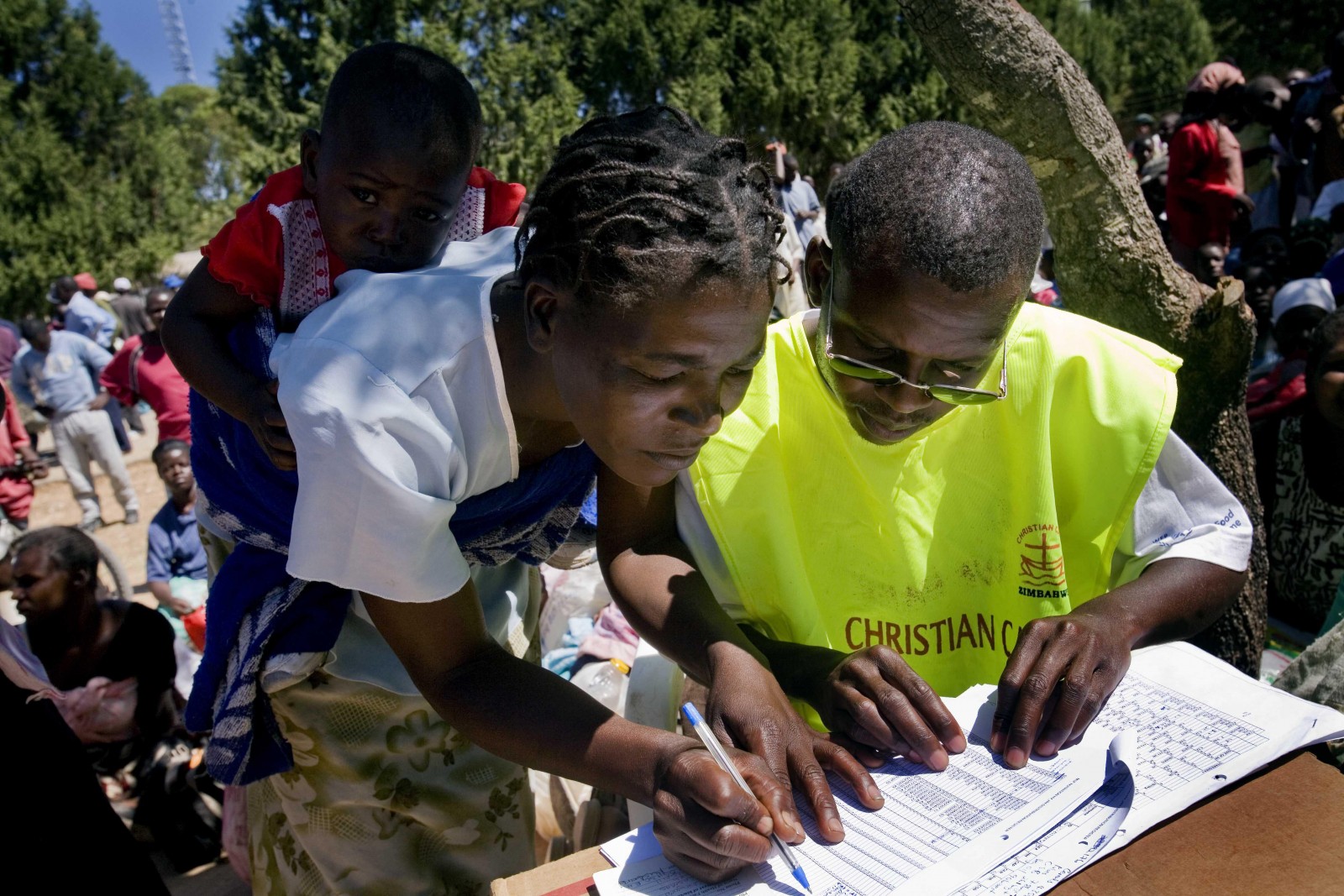
In 2009, the World Food Programme distributed food to thousands of Zimbabweans who were displaced by the country’s economic crisis. This year, a regional El Nino drought has put 4 million Zimbabwe citizens at risk of hunger. Photo courtesy Kate Holt / IRIN via Flickr Creative Commons.
Second is Zimbabwe’s acute lack of cash. In April the country’s central bank announced it would limit the amount that could be withdrawn from banks, and some ATMs stopped disbursing money altogether. As a result, people cannot access the funds they do have, and some forms of humanitarian aid could become untenable if the restrictions continue. Aid agencies often prefer to provide families with cash transfers instead of direct food deliveries because food is expensive to import and can have unintended effects on local markets and prices. The World Food Programme, for example, is providing about 60 percent of its assistance in Zimbabwe directly through food baskets and 40 percent through cash transfers, and hopes to reach 50 percent cash transfers by January. But if families cannot access the cash, this type of aid is no use.
You have a situation where there is a deadly cocktail of negative factors which directly have impacts on the basic livelihoods of millions of Zimbabweans.” –Eddie Rowe, Zimbabwe Country Director, World Food Programme
That leads to the third challenge—importing and distributing enough food in case local markets are unable to support demand, or communities do not have the cash to buy what is available. As of July, the Food and Agriculture Organization of the United Nations estimated that Zimbabwe will need to import nearly 1 million metric tons of grain. But the extent of the El Nino drought means that many other countries in the region are also competing for grain imports, and Zambia, a major regional supplier, banned exports in July to preserve supplies for its own people. Further complicating matters is Zimbabwe’s restriction on the importation of genetically modified crops, limiting the amount of corn and other grains it can procure from South Africa, another regional exporter.
“In a nutshell, what we are seeing now, even though in some markets there is availability of commodities, one thing which is clear is that prices are increasing on a weekly basis,” said Rowe, the WFP country director. “The projection is that by October, the prices will not only have increased to significant proportions, but then we would be having problems with availability of commodities. Unless and until there is a huge importation of commodities, then by November and December we would have an acute shortage of commodities, and where you would find commodities, the prices would be astronomical.”
Moreover, the Zimbabwe government has been accused of denying food aid to political opponents and their families. A report released this month by the independent Zimbabwe Human Rights Commission concluded that “the ruling party members were the major perpetrators in violations linked to distribution of food, agricultural inputs and other forms of aid.”
Funding, Logistics Lacking
Despite repeated calls for aid from humanitarian organizations and the government, as well as numerous reports detailing the unacceptable consequences should that aid fail to materialize, funding shortfalls continue to hinder the drought response. Only 14 percent of the United Nations’ humanitarian response plan for Zimbabwe — which includes provisions to improve food security, health, and water and sanitation — has been funded so far. Rowe estimates that the World Food Programme has received about 49 percent of what it requires to provide assistance through next March.
“It’s hard to get focus on this when it’s a slow-moving disaster and the impacts aren’t so visible,” said Thomas of Refugees International. “They aren’t visible until people are literally starving to death. And then you are getting in way too late. When you are addressing food security, you do not want to wait until the 11th hour to respond, because then it’s very unlikely to actually be effective.”
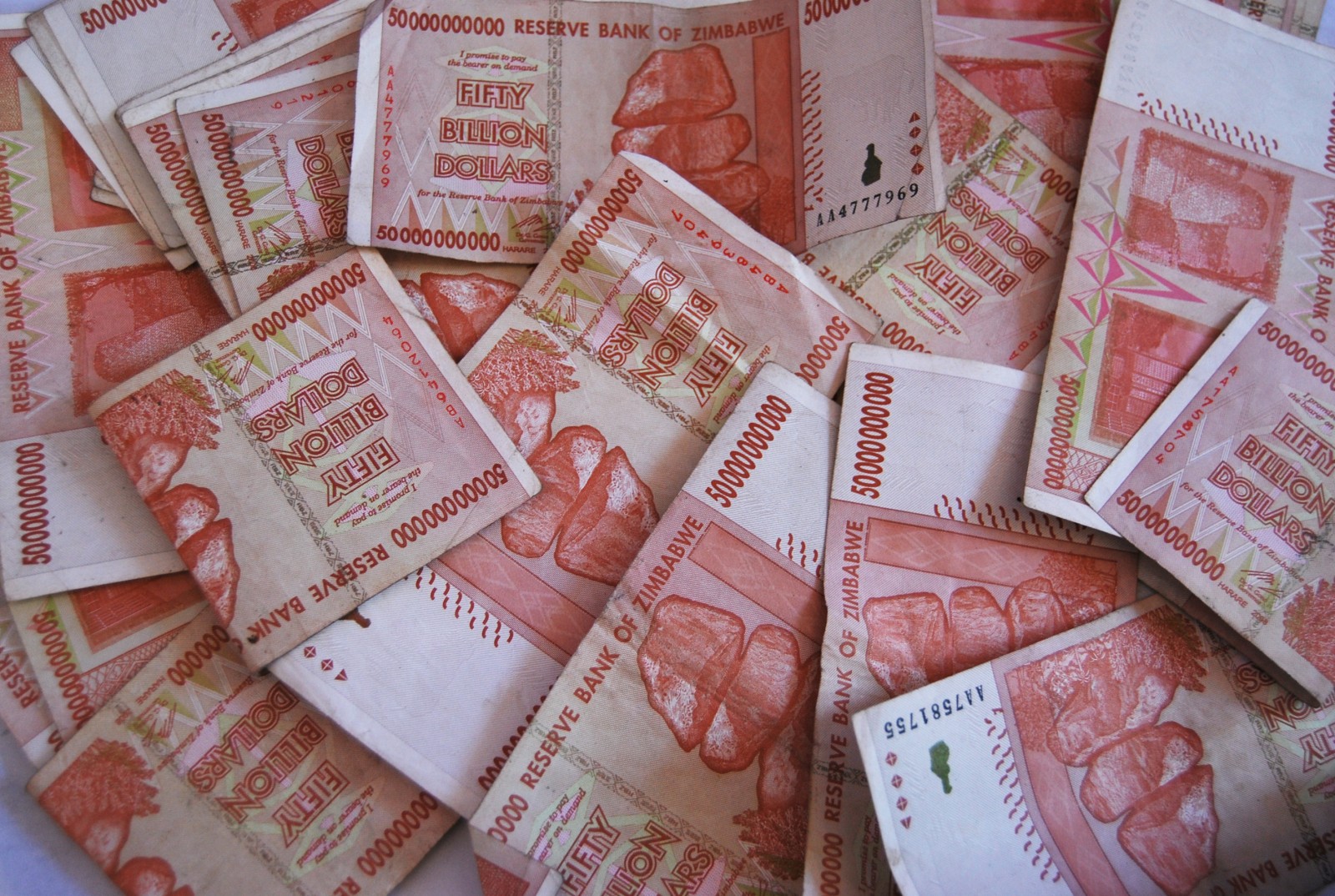
A hyperinflation crisis in Zimbabwe in 2009 forced the government to abandon the country’s local currency. Zimbabwe’s economy, however, remains weak. Photo courtesy Baynham Goredema via Flickr Creative Commons.
Both Thomas and Rowe acknowledged that donors have been generous, but also that they are stretched by numerous humanitarian crises around the globe. In the Horn of Africa alone, nearly 24 million people face critical and emergency levels of food insecurity due to El Nino-related droughts and floods. That’s in addition to the 40 million people identified as needing assistance in southern Africa. Because crops are harvested later in southern Africa than in eastern Africa, the food situation in the Horn of Africa gained more attention earlier in the fiscal year, according to Thomas. Aid organization staff are also stretched thin by the twin emergencies. Nonetheless, there is an urgent need to do more financially and to plan for contingencies such as food distribution hurdles, a continuation of the cash shortage, and the possible displacement of communities, she said.
“The volatility of the economy and the political situation right now, all that boils down to the fact that it is just very possible the situation could tip over into a complex crisis,” said Thomas. “There are a number of variables that are all mixing into this sort of explosive situation. And our takeaway from the drought is that we really must do as much as we can to ensure that we’re responding to the humanitarian needs and are prepared for the fact that the worst of the crisis is not yet here. The worst of the hunger and malnutrition is ahead of us, and if we don’t act early on that, it’s going to continue to add to the explosive mix in Zimbabwe right now.”
A Failure of Governance
Returning Zimbabwe to food security, however, will take a much larger effort than what aid organizations or government agencies can accomplish in the next six months. That is largely because the problem was not created by one El Nino, or even two consecutive failed harvests. The root of Zimbabwe’s pain, the reason rural communities are struggling to secure food and are reliant on outside assistance, is the same reason that urban workers are organizing in the streets of Harare: decades of failed policy decisions that eroded the economy and crippled the government’s ability to assist those in need.
What makes these place so vulnerable is not just weak economies and underdevelopment, it’s just poor governance.” –Alice Thomas, Climate Displacement Program Manager, Refugees International
“What makes these place so vulnerable is not just weak economies and underdevelopment, it’s just poor governance,” said Thomas, who noted that many Zimbabweans who spoke with Refugees International felt they had nowhere left to turn. “People were very upset that their government wasn’t really going to be able to help them. Even though the government has taken up some of the share of responding, people don’t feel that the government is doing enough for them. That’s the governance issue. So I think going forward, making people resilient to climate change or to natural hazards, making people resilient to any kind of shock, is not just an issue of smart agriculture or those kinds of things, it’s an issue of building government capacity to prepare and respond.”
In the early 2000s, land reform policies that forcefully redistributed farms from white Zimbabweans, mostly to supporters of the Mugabe government, signaled a shift away from Zimbabwe’s historically agricultural economy. The discovery of diamonds in 2005 further pushed the country away from food production and toward a mining-based economy, according to Maguwu of the Centre for Natural Resource Governance. Rural communities that once engaged in subsistence agriculture, for example, no longer grew their own food. In the short-term, the transition, together with the adoption of a multicurrency system, paid off. Zimbabwe’s economy grew an average of 8.7 percent each year between 2009 and 2012. The gains, however, have not been shared equally, Maguwu said.
“Zimbabwe is a country that is endowed with huge amounts of natural resources,” he told Circle of Blue. “But it’s the president, his family, and the ruling elites who are benefiting from these natural resources. The communities surrounding the big mines, they are the poorest, mainly because the elites are benefiting and they are silencing the communities.”

Protests this summer against President Robert Mugabe in Harare, Zimbabwe’s capital city, have called for the 92-year-old leader’s resignation. Photo courtesy GovernmentZA via Flickr Creative Commons.
Dependence on mining came to haunt the country after prices for commodities such as gold dropped in 2014. An economic slowdown in China, one of Zimbabwe’s most important trade and investment partners over the past decade, also curbed demand for the country’s products.
In addition, Zimbabwe has a history of strained relationships with western lending institutions, including the World Bank and the International Monetary Fund. The Mugabe government alienated the lending institutions with its land reform policies and owes $US 1.8 billion in arrears. Even China, Zimbabwe’s largest foreign investor, has cooled toward the country after Mugabe’s administration enacted an indigenization policy in April that claimed diamond mines run by Chinese companies. As a result, there is little outside financial help forthcoming to assist Zimbabwe’s government with its current problems.
“For the first time since independence, the Zimbabwe government is failing to pay its civil servants or state workers on time,” said Maguwu. “This is feeding into the growing discontent, and people have lost confidence in this government. Many people believe President Mugabe is not the right man to correct the wrongs he created in the first place.”
“It’s time that global citizens of conscience unite irrespective of race or tribe or gender, to say the suffering of the Zimbabwean people has been enough,” he added. “It’s time for this country to know real peace and take steps to recover from over three decades of dictatorship.”
A news correspondent for Circle of Blue based out of Hawaii. She writes The Stream, Circle of Blue’s daily digest of international water news trends. Her interests include food security, ecology and the Great Lakes.
Contact Codi Kozacek

